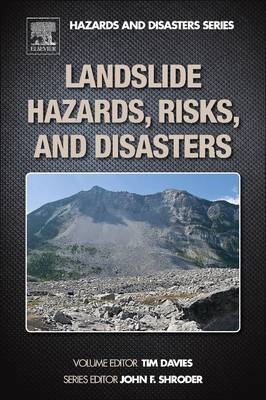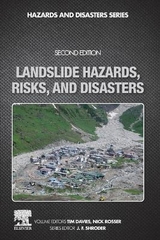
Landslide Hazards, Risks, and Disasters
Elsevier Science Publishing Co Inc (Verlag)
978-0-12-810111-7 (ISBN)
- Titel erscheint in neuer Auflage
- Artikel merken
Ramesh Sivanpillai, Senior Research Scientist, Dept of Botany, University of Wyoming, Laramie, WY, USA Ramesh Sivanpillai is a Remote Sensing Scientist at the Wyoming Geographic Information Science Center (WyGISC) at the University of Wyoming. His research interests include digital processing of satellite and aerial images, data fusion, image enhancement and classification. Tim Davies is a Professor in the School of Earth and Environment at the University of Canterbury (NZ). His research focusses on the application of geomorphology in prediction of landform response to disturbance, in particular in the context of natural hazard assessment and disaster impact reduction.
Introduction; Mass movement classification; Mass movement in soils; Soil creep and valley bulging; Mass movement in bedrock masses; Slope stability analysis; Slope monitoring; Landslide hazard, investigation, and mapping; Cost-effective slope stabilization; Quicksands; Expansive clays; Dispersive soils; Collapsible soils; Quick clays; Problem-soils as most expensive geohazard in world; Role of water in mass movement and problem soils; Undersea landslides; Subsidence; Snow avalanches; Arid soil hazards; Peat and coalbed hazards; Climate change and increased mass movement in collapse of permafrost regions; Paleoslope failures; Dating mass movements and ground collapses; Field, aerial photograph, and remote sensing assessments; Quantitative analysis; Living near steep slopes & valley margins; Community preparedness, response & recovery; Implications of climate change.
| Mitarbeit |
Chef-Herausgeber: John F. Shroder |
|---|---|
| Zusatzinfo | Approx. 150 illustrations (150 in full color); Illustrations, unspecified |
| Sprache | englisch |
| Maße | 152 x 229 mm |
| Themenwelt | Naturwissenschaften ► Biologie ► Ökologie / Naturschutz |
| Naturwissenschaften ► Geowissenschaften ► Geologie | |
| Technik ► Umwelttechnik / Biotechnologie | |
| ISBN-10 | 0-12-810111-3 / 0128101113 |
| ISBN-13 | 978-0-12-810111-7 / 9780128101117 |
| Zustand | Neuware |
| Haben Sie eine Frage zum Produkt? |
aus dem Bereich



